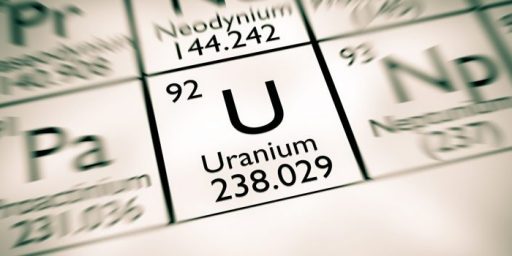INSIDE THE WMD DEBATE
Bart Gellman and Walter Pincus have a long piece in WaPo that tops the front page and fills two inside pages of the print edition entitled, “Depiction of Threat Outgrew Supporting Evidence.” While they present evidence that the Administration emphasized the worst case scenario, the headline doesn’t match the story, the heart of which appears several paragraphs into it (and off the front page):
By many accounts, including those of career officials who did not support the war, there were good reasons for concern that the Iraqi president might revive a program to enrich uranium to weapons grade and fabricate a working bomb. He had a well-demonstrated aspiration for nuclear weapons, a proficient scientific and engineering cadre, a history of covert development and a domestic supply of unrefined uranium ore. Iraq was generally believed to have kept the technical documentation for two advanced German centrifuge designs and the assembly diagrams for at least one type of “implosion device,” which detonates a nuclear core.
What Hussein did not have was the principal requirement for a nuclear weapon, a sufficient quantity of highly enriched uranium or plutonium. And the U.S. government, authoritative intelligence officials said, had only circumstantial evidence that Iraq was trying to obtain those materials.
But the Bush administration had reasons to imagine the worst. The CIA had faced searing criticism for its failures to foresee India’s resumption of nuclear testing in 1998 and to “connect the dots” pointing to al Qaeda’s attacks of Sept. 11, 2001. Cheney, the administration’s most influential advocate of a worst-case analysis, had been powerfully influenced by his experience as defense secretary just after the Persian Gulf War of 1991.
Former National Security Council official Richard A. Clarke recalled how information from freshly seized Iraqi documents disclosed the existence of a “crash program” to build a bomb in 1991. The CIA had known nothing of it.
“I can understand why that was a seminal experience for Cheney,” Clarke said. “And when the CIA says [in 2002], ‘We don’t have any evidence,’ his reaction is . . . ‘We didn’t have any evidence in 1991, either. Why should I believe you now?’ ”
Some strategists, in and out of government, argued that the uncertainty itself — in the face of circumstantial evidence — was sufficient to justify “regime change.” But that was not what the Bush administration usually said to the American people.
To gird a nation for the extraordinary step of preemptive war — and to obtain the minimum necessary support from allies, Congress and the U.N. Security Council — the administration described a growing, even imminent, nuclear threat from Iraq.
This is classic national security decision-making in action. Given imperfect intelligence as well as a reasonable belief that a regime means us harm, the safe course is not presuming the least compellng case supported by your intelligence.





So, what you’re saying is that the ability to make the right connections between the dots isn’t important at all? It’s like saying that the answers don’t matter as long as we have answers. It’s stating that it’s far more important to immediately react to the scary picture someone came up with by connecting the dots in any way they wanted to? Just coming up with arbitrary relationships using actual facts is hardly the kind of thing I want going on at the highest levels of this administration. Coming up with the wrong picture is just as bad as coming up with no picture at all. Just because crucial relationships and evidence was dropped from the picture doesn’t mean we should start creating relationships and evidence for the hell of it. They have to be the right relationships that are supported by the evidence.
Geesh. It’s a wonder this species is still alive.
They connected the dots and came up with a scary picture of a boogeyman that didn’t exist. It’s one thing to be fooled by these kind of shenanigans. It’s quite another to continue to believe that it’s true after the facts show otherwise. This faith based intelligence is pretty wacky and more than a little frightening.
Exactly right, John.
As much as JJ would like us to believe this administration was merely erring on the side of caution in a world of uncertain or ‘murky’ intelligence, it simply does not pass the smell test.
In many cases, this administration chose to act on intelligence which had been debunked or deemed highly unlikely or simply fabricated stories to fit their desired conclusions.
A National debate about how sure we should be of an iminent threat before launching a preemptive war would be interesting. We did not have one last time because we were assured that the the administration had solid, indisputable, bullet proof facts of both an al qaeda connection as well as WMD including a nuclear program. We could not wait because the warning sign might be a mushroom cloud.
The existence of reasons for a war that were not central to the arguments made by Mr. Bush do not mitigate his behavior. If a person defrauds you into buying an investment that you could have been convinced to purchase without the fraud, does your willingness to buy make the salesman any less dishonest?